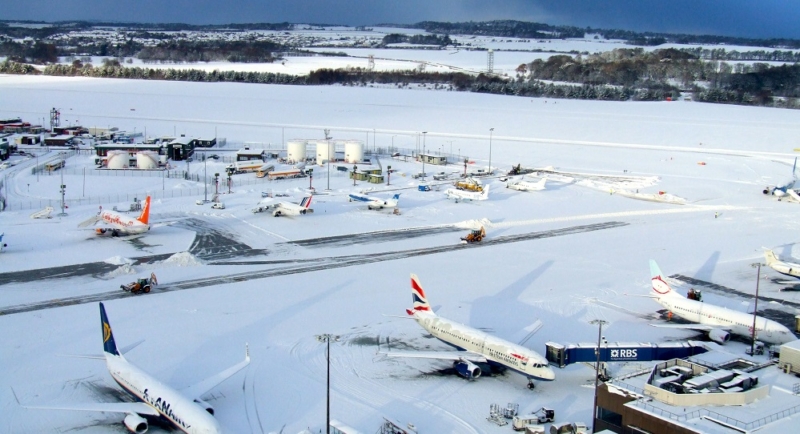Record demand will put pressure on airspace capacity
26 February 2016This year looks likely to be the busiest on record in the south east of England, with traffic expected to grow at all but one of London’s major airports.
Luton is expecting a 10% rise in traffic, while Stansted will likely see 184,000 movements in 2016, a rise of 8% on last year. London City will grow by 2% to 86,700 annual movements and Gatwick is hoping for its busiest ever summer, with a schedule that includes around 80 days of more than 900 daily movements – quite a challenge when you consider it only first broke the 900 barrier in 2013.
Even at Heathrow, which is already capacity constrained we are expecting to see an increase in the numbers of large aircraft delivering increased passenger numbers via a full summer schedule.
Overall we expect to handle around 1.14 million flights in and out of the five major London airports in 2016 to an ever increasing list of destinations. That’s a rise of 40,000 on last year and a trend that’s expected to continue for years to come, showing how vibrant our aviation industry is, as well as the general health of the economy.

So what does this mean for us as air traffic controllers? Finding ways to safely squeeze additional movements out of limited runway and airspace capacity is part of our job in supporting our airline and airport customers in delivering the schedules they want to run. We work closely with the airports in their planning process, particularly in the run up to busy periods, in order to understand the broader picture across the UK so we can identify the resources we might need to deal with the demand. Over the past few years technology enhancements, such as Airport Collaborative Decision Making, Airport and Airspace Capacity Management, iFACTS and Time Based Separation have helped us to improve efficiency and resilience.
However, that can only go on for so long. More fundamental change is now needed if we are to continue supporting the growth of the industry, regardless of a decision on any new runway.

Much of our airspace has its origins to when Boeing 707s were a common sight at UK airports.
The airspace structure in the UK was initially designed 50 years ago when the likes of the VC-10, the Vanguard and the Hawker Siddeley Trident ruled the skies. No one dreamed that one day over 2 million flights and 220 million people would pass through UK airspace every year. While the airspace has evolved over the years to help safely manage traffic growth, the current airspace structure simply won’t manage the rising demand we’re going to see in 10 years’ time without significant change today. We may even start to see symptoms of that future pressure on capacity during periods of peak demand this summer.
We wouldn’t accept having to drive on 1960s roads, so why do we accept it in our skies?
Without meaningful and widespread airspace modernisation and greater airport collaboration and coordination, the UK faces the prospect of delays 50 times what they are today, something that will cost airlines over £1bn each year and our wider economy an awful lot more. In reality the breakdown in connectivity would likely mean the erosion of our aviation industry with airlines taking their business elsewhere.
The challenge with airspace change, as with every other big infrastructure project, is that there are always winners and losers and it therefore requires political determination to help deliver. But the stakes are high and as an island nation that relies on aviation, we can’t afford to lose.
Comments
Please respect our commenting policy and guidelines when posting on this website.




26.02.2016
15:49
MJ
Who wins and who loses? Answer that… People on the ground don’t win so that reduces your options.
26.02.2016
20:06
Donald Bagwell
good article juliet; I’m not sure I would consider it a winner/loser option, as I feel there can be winners all around. Obviously each segment will need to be addressed and new concepts implemented for each. Surface movement, (i.e. runway scheduling) will take advantage of some of the latest and greatest concepts/algorithms being developed; as will departures & arrivals (STARS), these things will require even more freedom-of-choice on the pilot/aircrew side thus enabling work load reduction on the part of ATC.. Time Based Separation will deliver some benefits; but as you stated; only so much; Wake vortex separation will provide benefit; and as we enter the world of ADS-B(C), dynamic wake separation may become a reality, allowing for reduced spacing on arrivals and departures. other concepts “Traffic Aware Strategic Aircrew Requests (TASAR) combines ADS-B and airborne automation to enable user-optimal in-flight trajectory replanning” are things that will have to be considered during the enroute phase of flight to both help with congestion, and ATC workload reduction. Indeed a huge task but one in which I feel there’s plenty of expertise out there to handle.
27.02.2016
06:20
lesf
You are tempting us to conclude that a new runway is the only answer but you ignore the fact that Birmingham’s capacity is only 30 % used. This year I used it for the first time for my long flight instead of Hrow – because it was possible with th extended runway and new services. Ww could also squeeze more out of existing capacity by changing APD from per passenger to per plane because that would encourage airlines to fill all the seats.
11.03.2016
18:10
LesF
There would not be the problem of turbulence from large aircraft forcing ATC’s to leave a large margin for following small aircraft at H’row, if those small aircraft were moved to Northolt with a new east-west runway. The two airports could then operate as one when the two branches of the Piccadilly line are joined so all trains go round the loop instead of reversing at T5 and reversing at Uxbridge. With the addition of Metropolitan trains and some Central trains diverted from West Ruislip to Uxbridge, plus a dedicated shuttle for airside passengers and checked in baggage, a new rail station at Northolt airport would be better connected than H’row. And no houses or businesses need be lost. We should get on with it instead of prevaricating over a 3rd runway at H’row while Dubai and Istanbul take the business away.